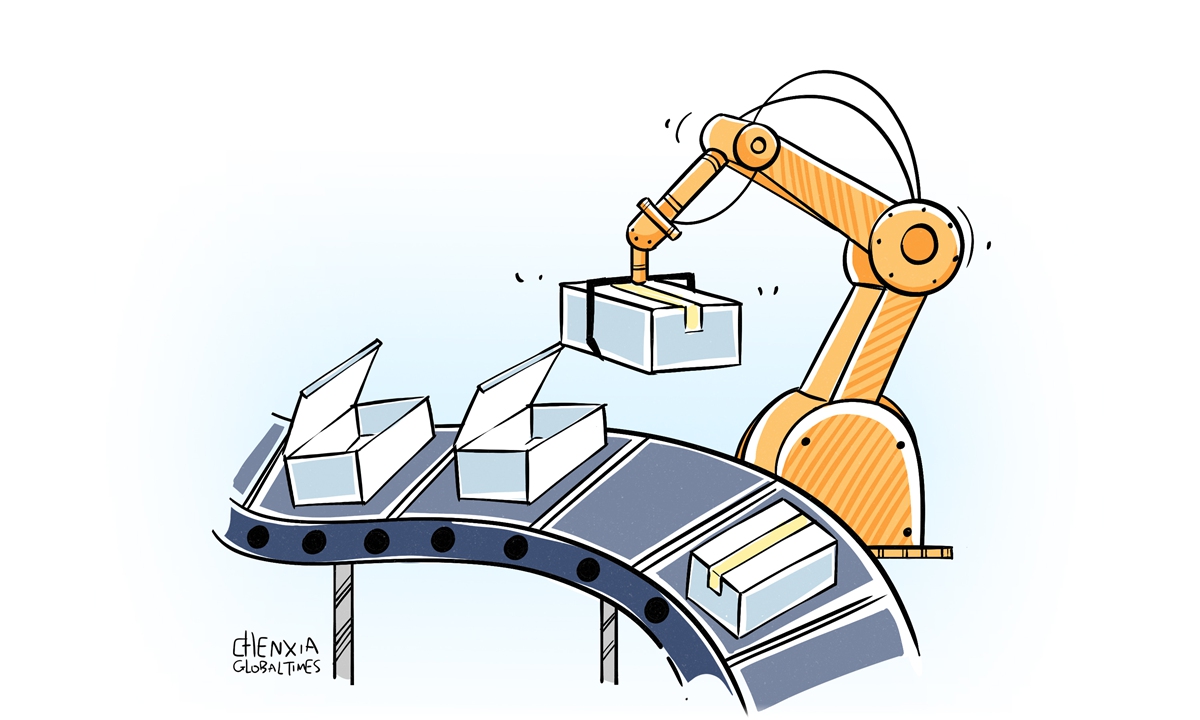
Illustration: Chen Xia/GT
India has ambitions to become a major manufacturing hub, and it has been courting foreign firms to set up operations in the country. The process involves complicated issues. How India chooses to view its processing industry may be a key variable for the future of India's manufacturing development.
In fiscal year 2023-24, which ran from April 2023 to March 2024, India imported electronic components worth more than $12 billion from the Chinese mainland and $6 billion from Hong Kong, with the two accounting for more than half of all such imports to India, the Indian Express reported on Sunday.
The article has sparked discussion online, with some netizens saying that multiple factors keep India as an assembler instead of a manufacturer of electronics.
It's not the first time similar discussions have taken place in India. For instance, some Indian economists were quoted by media reports as saying that the boom in India's mobile phone exports was primarily propelled by assembly rather than genuine manufacturing within the country.
One result of the boom in assembly manufacturing is an increase in the imports of intermediate products, such as parts and components. Growing "Indian dependence on Chinese industrial goods" raises concerns in the South Asian country, but these worries are unnecessary. A zero-sum mentality will hinder the long-term development of India's manufacturing industry.
As the restructuring of the global industrial chain seems to have accelerated, India has attracted interest as a production and processing base, particularly for key manufacturing sectors like mobile phones. This is certainly good news for the Indian economy. At the very least, India's continued development of its processing industry represents a significant opportunity to fuel job creation for its rising population.
India's manufacturing sector has grown fast but has yet to become truly sophisticated. High production costs, incomplete industrial chains and outdated infrastructure make India an assembly base, instead of a manufacturing location for some multinational enterprises. It's impossible to solve every problem overnight. Its manufacturing ambitions need to be advanced step-by-step with patience.
The development of manufacturing in India should be carried out in phases. India should improve the investment environment, do everything possible to encourage the development of the processing industry, build itself into a processing hub, and then gradually develop into a manufacturing powerhouse, and even a hub for manufacturing innovation.
China and India have big potential for cooperation, in which China's possession of manufacturing technologies and its exports of machinery equipment, intermediate products and core components can be instrumental in India's development of its processing industry.
India's imports of goods, components and raw materials from China have continued to increase. This trend underscores the complementary nature of economic and trade cooperation between the two countries. Importing from China is advantageous and even essential for India's economy and manufacturing sector.
India's imports from China across at least 25 major commodity groups such as consumer electronics, auto components, and iron and steel products rose in fiscal year 2022-23. China was India's largest trading partner again in fiscal year 2023-24, with imports from China increasing by 3.24 percent year-on-year to $101.7 billion, according to media reports.
India's ambition to bolster manufacturing is fundamentally inseparable from its close association with "Made in China," especially in the production of intermediate and finished goods in industries such as pharmaceuticals, automobiles and electronics.
This situation fully shows that strengthening economic and trade cooperation with China benefits Indian industry and is necessary for India to achieve its manufacturing ambitions and long-term economic goals.
Hopefully, India can take concrete steps to integrate into the Asia-Pacific industrial chain, which includes China as an indispensable link, instead of allowing harmful geopolitical and protectionist thinking to further hinder the rapid development of India's manufacturing industry.
The author is a reporter with the Global Times. bizopinion@globaltimes.com.cn




